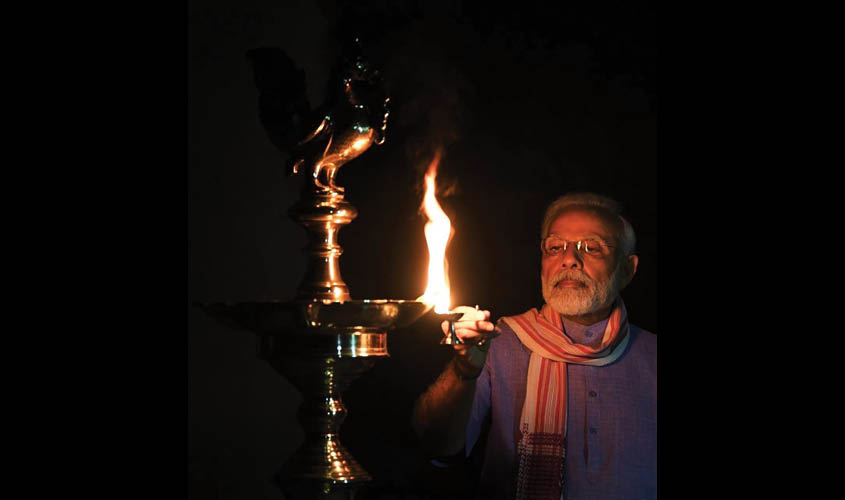The recent announcement of the Rs 20 lakh crore special economic package has given rise to the debate on whether or not it will help revive Indian economy and industry. Some argue that the economic stimulus will be of great relevance in addressing the challenges emanating from Covid-19 on India’s economic growth. Others believe that the mechanism to deal with such a revival package is of greater importance than the actual package. The regulations for disbursements of funds should not be cumbersome and how these will help harness India’s dream of self-reliance.
The post Covid-19 economic revival plan is in the public domain. As of now the emphasis of the government is in the revival of the small and medium sector, which is considered the backbone of the middle income group consumers. The obvious reference to swadeshi economics without naming it in so many words is the Prime Minister’s way of reiterating what the Sarsanghachalak of the Rashtriya Swayamsevak Sangh (RSS) has been saying for long. In fact, in his address from Nagpur in October last he had made specific references to the revival of Indian industry for self reliance. Narendra Modi’s reference to Atmanirbhar Bharat Abhiyan is largely the same theme in different words.
The Prime Minister’s announcement has laid emphasis on four important elements of economic revival. The first one is massive public spending and increased investment. As of now the industry can only expect domestic investment, which is difficult to find but easy to provide. There is little doubt that the credit availability with the banks is sufficient but the off-take is limited due to a number of factors. The long list of non performing assets and the subsequent punitive action
Lockdown 4 is expected to be less restrictive, but combined with increased caution and strict implementation. Such a carefully calibrated lockdown, especially limited to areas designated as contagious zones or red zones, will allow normal economic activities in other areas with less health hazards. But such a step is not without the possibility of serious risks.
The third aspect is the Prime Minister’s resolve to initiate policy reforms so that ease of business does not remain a mere slogan. Indian industry has to become cost effective to compete in the global trade arena.
The fourth and the most important area is that of making the country self-reliant through structural changes and a series of policy amendments. This is easier said than done. The last two or more decades have seen the worst kind of dependence on imports to meet even day to day domestic needs. The total decimation of the manufacturing sector dealt a blow to the very fundamentals of industrial growth and every economic aspect associated with it. Reviving the manufacturing sector is not going to be an easy task and will need more than mere structural changes. It needs a paradigm shift in the way we treat the business community and free the economy of the fetters that have bound them for so long.
Such a tectonic shift in our economic policy will not only revive Indian industry but also provide the necessary template for foreign industries and investments to consider India as a safe and lucrative destination. The Prime Minister has indicated in his televised address about the five fundamentals that he would be looking into to make India self sufficient: All round economic improvement, state-of-the-art infrastructure, technically oriented administrative and governance system, vibrant and skilled demography and optimum utilisation of the demand-supply dynamics of the market through effective supply chain mechanism.
The cumulative effect of the economic package will produce encouraging results if implemented with sincerity and practised in a corruption free atmosphere. With the kind of leadership that Narendra Modi has provided there is little doubt that the implementation of the economic package will be done with nil pilferages. But what needs to be done is much more than self-reliant economy and revival of small and medium industry to meet local demand. Being vocal on local is no doubt the first of many steps to reach the pinnacle of global trade. The world has enough scope to absorb all that India can produce and supply. Covid-19 has disrupted the global demand-supply chain and dented the economic confidence of the world. Global trade institutions are in a bad shape and will start looking for an alternative supplier who can be depended upon and who will respect the rules of the game.
India has to become self-reliant, become a vibrant manufacturing economy strengthened by investments and technological prowess, but not stop at that. There is an immediate need to provide a new template for globalisation with a human face. India’s “Make in India” slogan will get a renewed emphasis from this special economic package. The manufacturing sector will get a boost by focusing on local and then slowly and steadily going global. The Prime Minister obviously shall get admiration and not admonition. At this critical juncture, the new push to the revival of Indian economy will be a good beginning to make India sustainable in the foreseeable future and realise all the dreams of becoming a great power with a lot of responsibilities to lead the world affairs.
Dr Arvind Kumar is a Professor and Head at the Department of Geopolitics and International Relations at Manipal Academy of Higher Education (MAHE), Manipal. Seshadri Chari is a well known political commentator and strategic analyst.

